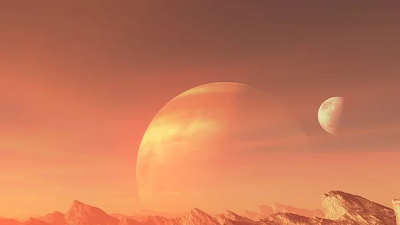645

Saturn’s largest moon ‘Titan’, looks very familiar to Earth from space. The moon has rivers, lakes and seas filled by rain falling through a thick atmosphere. Though these landscapes look similar, they are composed of different materials. Liquid methane streams streak Titan’s icy surface, and nitrogen winds build hydrocarbon sand dunes.
Image Credits: Pixabay
The mechanical properties of these materials are different from those of silicate-based substances that make up other sedimentary bodies in the solar system. These materials make Titan’s landscape formation mysterious. Researchers at Stanford University have shown how Titan’s different plains, labyrinth terrains and dunes could be formed by identifying a process of the formation of sand grains and bedrock depending on how the stream flows and the wind blows.
Titan is the only other body in the solar system that has a seasonal liquid transport cycle (precipitation) like Earth. It is also a target for space exploration due to its potential habitability. The new model of the Titan showed how the seasonal cycle drives the movement of grains over its surface.
“Our model adds a unifying framework that allows us to understand how all of these sedimentary environments work together,” said Mathieu Lapôtre, an Assistant Professor of Geological Sciences at Stanford’s School of Earth, Energy & Environmental Sciences (Stanford Earth). “If we understand how the different pieces of the puzzle fit together and their mechanics, then we can start using the landforms left behind by those sedimentary processes to say something about the climate or the geological history of Titan – and how they could impact the prospect for life on Titan.”
A Missing Procedure
Researchers had to solve one of the significant questions about sediment on the planetary body to make a model that could imitate the formation of Titan’s different landscapes. The question was, how can organic compounds that are weaker than inorganic silicate grains on Earth, convert into grains to form various structures rather than blowing away as dust or wearing down?
On Earth, silicate minerals and rocks get eroded into sediment grains and are deposited in layers of sediments through streams and winds. These grains turn back into rock with the help of groundwater, pressure and heat. The erosion process continues, and materials are recycled through Earth’s layers.
Researchers thought that similar processes formed the plains, labyrinth terrains and dunes on Titan. But unlike on Venus, Mars and Earth, where sediments are derived from silicate rocks, on Titan, they are thought to be composed of solid organic compounds. The scientists were unable to display how the organic compounds turn into sediment grains that can be transferred across the moon’s landscapes.
“As winds transport grains, the grains collide with each other and with the surface. These collisions tend to decrease grain size over time. What we were missing was the growth mechanism that could counterbalance that and enable sand grains to maintain a stable size through time,” said Lapôtre.
An Unfamiliar Analogue
Researchers solved the mystery about sediments by considering them on Earth called ooids. These sediments are small, spherical grains often found in shallow tropical seas, such as around the Bahamas. They are formed when calcium carbonate is taken from the water column and attached in layers around the grains, such as quartz.
The process of chemical precipitation allows ooids to grow, while the erosion process slows the growth as the grains collide with each other by storms and waves. These two processes balance each other to form a constant grain size. Researchers suggested that these processes also happen on Titan.
“We were able to resolve the paradox of why there could have been sand dunes on Titan for so long even though the materials are very weak,” said Lapôtre. “We hypothesized that sintering – which involves neighbouring grains fusing together into one piece – could counterbalance abrasion when winds transport the grains.”
Landscapes Around The World
Researchers used data about Titan’s climate and the direction of the wind that transports sediments to describe the parallel bands of geological formations: labyrinth terrains near the poles, plains at the mid-latitudes and dunes near the equator.
Atmospheric modeling and data of the Cassini mission (space exploration mission to Saturn) showed that winds were common near the equator, supporting the idea of less sintering, a process of forming solid mass by means of heating without liquefaction, and fine sand grains could be created there that are important components of dunes. The researchers predicted a break in sediment transportation at mid-latitudes on either side of the equator, where sintering could dominate and create coarser grains. These grains turn into bedrock that makes up Titan’s plain.
Titan’s labyrinth terrains near the poles were also formed from the sand grains. The researchers thought that different cliffs could be like karsts (topography formed by the dissolution of rocks like limestone) on Earth. But on Titan, these could be made from organic sandstones. Sediments were mostly transported by rivers than winds as river flow and rainstorms were more frequent near the poles. Also, the process of sintering and abrasion could supply the coarse sand grains for the formation of labyrinth terrains.
“We’re showing that on Titan – just like on Earth and what used to be the case on Mars – we have an active sedimentary cycle that can explain the latitudinal distribution of landscapes through episodic abrasion and sintering driven by Titan’s seasons,” said Lapôtre. “It’s pretty fascinating to think about how there’s this alternative world so far out there, where things are so different, yet so similar.”
The detailed study has been published in the journal Geophysical Research Letters.
Follow us on Medium!

